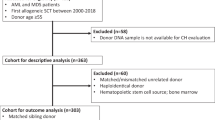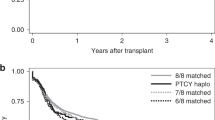Abstract
It was previously shown that chronic myeloid leukemia (CML) patients transplanted with peripheral blood progenitor cells (PBPC) from HLA-C allele-matched donors had better clinical outcome when lacking the HLA-C-encoded KIR epitope C2. We investigated whether this holds true in other diseases and in HLA-C allele-mismatched patients. Twenty-four myelodysplastic syndrome (MDS), 39 acute myeloid leukemia (AML)/CML, and 34 acute lymphoblastic leukemia/non-Hodgkin lymphoma patients received unrelated unmanipulated PBPC. HLA matching was analyzed retrospectively (including DNA-based direct sequencing of HLA-C). Only in AML/CML, the C2 ligand was associated with impaired overall survival (OS, p < 0.05). We next calculated the impact of donor/recipient HLA-C allele matching within the C1 and C2 groups. Surprisingly, AML/CML and MDS patients with C2 ligands profited from HLA-C allele mismatching (OS, p < 0.01), whereas in the C1 group, allele matching was beneficial (p < 0.05). HLA-C allele mismatching in the C2 KIR ligand group was associated with lower TRM (OR 0.48, p < 0.009) and lower relapse rate (OR 2.7 p < 0.1) when compared to allele-matched C2 patients. Thus, patients could be assigned to a low- and a high-risk group according to their C1/C2 ligand status and the HLA-C allele matching degree. These data suggest that four-digit allele matching of HLA-C has differential effects dependent on the presence of C1 and C2 KIR epitopes in the patient.



Similar content being viewed by others
References
Anfossi N, Andre P, Guia S, Falk CS, Roetynck S, Stewart CA, Breso V, Frassati C, Reviron D, Middleton D, Romagne F, Ugolini S, Vivier E (2006) Human NK cell education by inhibitory receptors for MHC class I. Immunity 25(2):331–342
Cooley S, Weisdorf DJ, Guethlein LA, Klein JP, Wang T, Le CT, Marsh SG, Geraghty D, Spellman S, Haagenson MD, Ladner M, Trachtenberg E, Parham P, Miller JS (2010) Donor selection for natural killer cell receptor genes leads to superior survival after unrelated transplantation for acute myelogenous leukemia. Blood 116(14):2411–2419
Enczmann J, Rinker M, Kiesel U, Kuhrober A, Kogler G, Nurnberger W, Gobel U, Wernet P (1999) Donor selection process for allogeneic hematopoietic stem cell transplantation at the university hospital of Dusseldorf (1997–1998). Klin Padiatr 211(4):218–223
Fine JP, Gray RJ (1999) A proportional hazards model for the subdistribution of a competing risk. J Am Stat Assoc 94:496–509
Fischer JC, Ottinger H, Ferencik S, Sribar M, Punzel M, Beelen DW, Schwan MA, Grosse-Wilde H, Wernet P, Uhrberg M (2007) Relevance of C1 and C2 epitopes for hemopoietic stem cell transplantation: role for sequential acquisition of HLA-C-specific inhibitory killer Ig-like receptor. J Immunol 178(6):3918–3923
Flomenberg N, Baxter-Lowe LA, Confer D, Fernandez-Vina M, Filipovich A, Horowitz M, Hurley C, Kollman C, Anasetti C, Noreen H, Begovich A, Hildebrand W, Petersdorf E, Schmeckpeper B, Setterholm M, Trachtenberg E, Williams T, Yunis E, Weisdorf D (2004) Impact of HLA class I and class II high-resolution matching on outcomes of unrelated donor bone marrow transplantation: HLA-C mismatching is associated with a strong adverse effect on transplantation outcome. Blood 104(7):1923–1930
Giebel S, Locatelli F, Wojnar J, Velardi A, Mina T, Giorgiani G, Krawczyk-Kulis M, Markiewicz M, Wylezol I, Holowiecki J (2005) Homozygosity for human leucocyte antigen-C ligands of KIR2DL1 is associated with increased risk of relapse after human leucocyte antigen-C-matched unrelated donor haematopoietic stem cell transplantation. Br J Haematol 131(4):483–486
Glucksberg H, Storb R, Fefer A, Buckner CD, Neiman PE, Clift RA, Lerner KG, Thomas ED (1974) Clinical manifestations of graft-versus-host disease in human recipients of marrow from HL-A-matched sibling donors. Transplantation 18(4):295–304
Graef T, Moesta AK, Norman PJ, Abi-Rached L, Vago L, Older Aguilar AM, Gleimer M, Hammond JA, Guethlein LA, Bushnell DA, Robinson PJ, Parham P (2009) KIR2DS4 is a product of gene conversion with KIR3DL2 that introduced specificity for HLA-A*11 while diminishing avidity for HLA-C. J Exp Med 206(11):2557–2572
Hsu KC, Gooley T, Malkki M, Pinto-Agnello C, Dupont B, Bignon JD, Bornhauser M, Christiansen F, Gratwohl A, Morishima Y, Oudshoorn M, Ringden O, van Rood JJ, Petersdorf E (2006) KIR ligands and prediction of relapse after unrelated donor hematopoietic cell transplantation for hematologic malignancy. Biology of blood and marrow transplantation 12(8):828–836
Kim S, Poursine-Laurent J, Truscott SM, Lybarger L, Song YJ, Yang L, French AR, Sunwoo JB, Lemieux S, Hansen TH, Yokoyama WM (2005) Licensing of natural killer cells by host major histocompatibility complex class I molecules. Nature 436(7051):709–713
Knipper AJ, Hakenberg P, Enczmann J, Kuhrober A, Kiesel U, Kogler G, Wernet P (2000) HLA-DRB1,3,4,5 and -DQB1 allele frequencies and HLA-DR/DQ linkage disequilibrium of 231 German caucasoid patients and their corresponding 821 potential unrelated stem cell transplants. Hum Immunol 61(6):605–614
Leung W, Iyengar R, Turner V, Lang P, Bader P, Conn P, Niethammer D, Handgretinger R (2004) Determinants of antileukemia effects of allogeneic NK cells. J Immunol 172(1):644–650
Ljunggren HG, Karre K (1990) In search of the 'missing self': MHC molecules and NK cell recognition. Immunol Today 11(7):237–244
Lodewyck T, Oudshoorn M, van der Holt B, Petersen E, Spierings E, von dem Borne PA, Schattenberg A, Allebes W, Groenendijk-Sijnke M, Duinhouwer L, Willemze R, Lowenberg B, Verdonck LF, Meijer E, Cornelissen JJ (2011) Predictive impact of allele-matching and EBMT risk score for outcome after T-cell depleted unrelated donor transplantation in poor-risk acute leukemia and myelodysplasia. Leukemia 25(10):1548–1554
Morishima Y, Sasazuki T, Inoko H, Juji T, Akaza T, Yamamoto K, Ishikawa Y, Kato S, Sao H, Sakamaki H, Kawa K, Hamajima N, Asano S, Kodera Y (2002) The clinical significance of human leukocyte antigen (HLA) allele compatibility in patients receiving a marrow transplant from serologically HLA-A, HLA-B, and HLA-DR matched unrelated donors. Blood 99(11):4200–4206
Petersdorf EW, Anasetti C, Martin PJ, Gooley T, Radich J, Malkki M, Woolfrey A, Smith A, Mickelson E, Hansen JA (2004) Limits of HLA mismatching in unrelated hematopoietic cell transplantation. Blood 104(9):2976–2980
Ruggeri L, Capanni M, Urbani E, Perruccio K, Shlomchik WD, Tosti A, Posati S, Rogaia D, Frassoni F, Aversa F, Martelli MF, Velardi A (2002) Effectiveness of donor natural killer cell alloreactivity in mismatched hematopoietic transplants. Science 295(5562):2097–2100
Shulman HM, Sullivan KM, Weiden PL, McDonald GB, Striker GE, Sale GE, Hackman R, Tsoi MS, Storb R, Thomas ED (1980) Chronic graft-versus-host syndrome in man. A long-term clinicopathologic study of 20 Seattle patients. Am J Med 69(2):204–217
Thomas ED, Blume KG (1999) Historical markers in the development of allogeneic hematopoietic cell transplantation. Biol Blood Marrow Transplant 5(6):341–346
Uhrberg M, Valiante NM, Shum BP, Shilling HG, Lienert-Weidenbach K, Corliss B, Tyan D, Lanier LL, Parham P (1997) Human diversity in killer cell inhibitory receptor genes. Immunity 7(6):753–763
Uhrberg M, Parham P, Wernet P (2002) Definition of gene content for nine common group B haplotypes of the Caucasoid population: KIR haplotypes contain between seven and eleven KIR genes. Immunogenetics 54(4):221–229
van Bergen J, Thompson A, Retiere C, Trowsdale J, Koning F (2009) Cutting edge: killer Ig-like receptors mediate "missing self" recognition in vivo. J Immunol 182(5):2569–2572
Velardi A (2008) Role of KIRs and KIR ligands in hematopoietic transplantation. Curr Opin Immunol 20(5):581–587
Verheyden S, Ferrone S, Mulder A, Claas FH, Schots R, De Moerloose B, Benoit Y, Demanet C (2009) Role of the inhibitory KIR ligand HLA-Bw4 and HLA-C expression levels in the recognition of leukemic cells by Natural Killer cells. Cancer Immunol Immunother 58(6):855–865
Woolfrey A, Klein JP, Haagenson M, Spellman S, Petersdorf E, Oudshoorn M, Gajewski J, Hale GA, Horan J, Battiwalla M, Marino SR, Setterholm M, Ringden O, Hurley C, Flomenberg N, Anasetti C, Fernandez-Vina M, Lee SJ (2011) HLA-C antigen mismatch is associated with worse outcome in unrelated donor peripheral blood stem cell transplantation. Biology of blood and marrow transplantation 17(6):885–892
Acknowledgments
This work was supported by a grant from the LEUKÄMIE LIGA e.V. Düsseldorf, Germany to JCF and a grant from the Deutsche José Carreras Leukämie-Stiftung to MU.
Authorship and Disclosures
JCF designed the research, interpreted data, performed the statistical analysis, drafted the manuscript, and critically revised the manuscript. GK provided patients, collected and assembled clinical data, and critically revised the manuscript. JE provided HLA and KIR typing and critically revised the manuscript. RH designed the research, provided administrative support, and critically revised the manuscript. MU provided KIR typing, designed research, drafted the manuscript, and critically revised the manuscript.
Conflict of interest
There are no competing interests in relation to the work described.
Author information
Authors and Affiliations
Corresponding author
Rights and permissions
About this article
Cite this article
Fischer, J.C., Kobbe, G., Enczmann, J. et al. The impact of HLA-C matching depends on the C1/C2 KIR ligand status in unrelated hematopoietic stem cell transplantation. Immunogenetics 64, 879–885 (2012). https://doi.org/10.1007/s00251-012-0648-7
Received:
Accepted:
Published:
Issue Date:
DOI: https://doi.org/10.1007/s00251-012-0648-7




